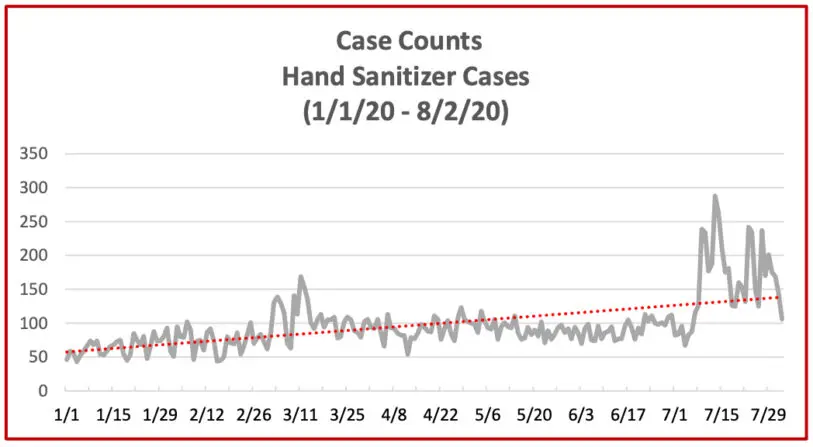The number of calls about hand sanitizer have skyrocketed 70% this year, according to new data from the American Association of Poison Control Centers (AAPCC) released yesterday.
The number of cases between January 1 and August 2 was 21,074, up from 12,426 during the same period in 2019. More than 12,000 of the current ones involved children age 5 or younger.
None of the cases resulted in death, though 2% had moderate effects and 9%, minor effects.
The cases were highest in mid-July, with one day clocking close to 300 calls at the 55 U.S. poison control centers. Last month saw 5,097 calls, compared to 1,529 in July 2019.

Methanol, also known as wood alcohol, may be toxic when absorbed through the skin or eaten, the Centers for Disease Control and Prevention says.
Hand sanitizer isn’t the only product causing problems. AAPCC’s National Poison Data System shows that the number of disinfectant exposure cases jumped 58% from the start of the year through yesterday, from 18,797 to 11,860. Those counts were highest in April. Kids aged 5 and below had an estimated 5,000 incidents and adults 20-39 had more than 4,000.
Also topping out that month were the number of bleach incidents. They rose 38%—32,617 versus 23,709. Children ages 5 and younger and people between the ages 20 and 39 both had more than 8,000 each, while adults 40-59 had around 5,000.
Disinfectant and bleach killed no one in these cases.
April was the month when President Donald Trump suggested injecting disinfectant as a way to fight COVID-19, prompting Clorox and Lysol to release statements to warn Americans not to do it. Plus, April was when the full force of the coronavirus pandemic first hit the United States, causing panic and the mass purchasing of cleaning supplies.
“We’re being much more vigilant about sanitization and as a result, there’s a lot more of these supplies for people or kids to get into inadvertently. We’ve had some very bad advice from out national leadership. There are people who are doing things that may have been said in jest that they don’t realize, because of who it’s coming from,” says Ed Elder, director of the Zeeh Pharmaceutical Experiment Station at the University of Wisconsin-Madison.
Trump later said he was being sarcastic about his injection recommendation.
The American Association of Poison Control Centers advises people to read instructions on products before using them, refrain from mixing cleaners, and store them safely and high up.
Recognize your brand's excellence by applying to this year's Brands That Matters Awards before the early-rate deadline, May 3.
